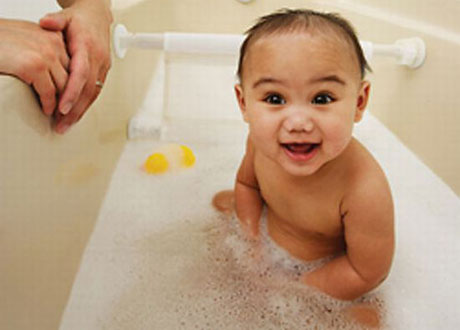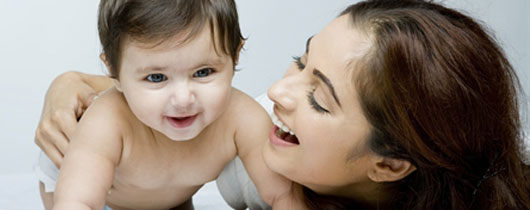
When to begin baby baths?
The umbilical cord stump will take around a week or two to fall off. So till the stump falls and the navel area is completely healed, you should only give your baby sponge baths.
How babies react to bathing?
Newborn babies (first few months) do not enjoy bathing. But as the baby grows older, bath time will become a thoroughly satisfying experience. He/she will enjoy freedom from clothes which hamper his movements, and he’ll stretch and kick, crowing with delight. Merely getting clean is the least of his concerns. He becomes a real showoff and it is a pleasant moment to share with the family. Try to make a space in your busy day so that you, too, can enjoy playing with the baby who is so alert and happy enjoying his damp sweetness as you him dry and the clean soap smell clinging to his scalp.
What are the items required for bathing?
1. The bath/tub: Baby baths are usually very simple, and made of plastic. Some types can be put on a stand. You will probably find putting the tub on the floor a little awkward. It will be difficult to lower the baby into the water and bending over is not a very pleasant experience too. So if bath is kept on a table or higher up, it will be a better and comfortable experience. In fact, you do not really need a bath and many families use the kitchen sink or washbasin. This is quite satisfactory as long as you make sure that it is spotlessly clean before you put the baby in it.
2. A warm/cozy room: The room temperature should be cozy, neither too hot nor too cold. Ideally it should be between 24-28 degrees. Close or open the door accordingly to regulate the temperature of bath room.
3. A low chair, comfortable as well as sturdy, for you to sit on.
4. Soap and a dish to keep it in.
5. A flannel or soft sponge for washing the baby with.
6. A towel.
7. Clean clothes and nappies: Air and dry these and arrange them in order so you can put them on easily.
8. Plastic apron: Other useful item is a plastic apron or sheet to protect your clothes.
9. A bucket for dirty clothes and nappies.
10. A plastic bag for soiled disposable items, such as cotton wool and disposable nappies.
11. Toilet items: Keep these in a box or a tray. The sort of things you will need will be baby powder, cream for the nappy area and olive oil to rub into the scalp when necessary. You will need plenty of cotton wool and tissues to clean the nappy area, and some twists of cotton wool for the nose, cotton buds on sticks are useful. You can now start to get the bath ready.
What is the proper bathing procedure?

1. Fill the bath with hot and cold water together. If you want to be very safe, start by pouring some cold water into the bath followed by hot water, until it is comfortably warm. Test it by putting your finger in it. You should be very careful not to put hot water into the bath first: you might forget to test it and could scald the baby by putting him in water that is too hot. Accidents can be avoided if you make sure the temperature is around blood heat (38°C or 100°F).
2. Undress the baby. It is probably best to do this on your lap, but some women find it easier on a table, laying the baby on a special mat, towel or blanket. Even if you usually use the table, it is good idea to have some practice in dressing and undressing the baby on your lap. Then you will not feel flummoxed if you ever have to undress the baby and have nowhere to put him down on a journey or a visit, for example.
3. Wash the baby's face with clean water and pat it dry. You can prevent him getting cold by keeping him wrapped in a towel while you wash his face and head.
4. Nose, ears and eyes. There is no need to clean the nose unless it looks clogged. If it does appear to be dirty, you can clean it with a cotton wool bud or a twist of cotton wool. You do not need to do anything to the ears, and the eyes can be left alone if they look normal. If there is some discharge from the eyes, so that the lids are stuck together, you can bathe them gently with cotton wool soaked in warm, boiled water. Use enough to clear the eye discharge and allow the eyes to open.
5. Wash the head using a little soap and massage the scalp gently. Do not rub soap directly into the scalp. Instead work up lather in your hand and then use it over the head. Keep soapy water out of the baby's eyes. After applying it, rinse away the soap and dry the head. If you notice any scurf on the scalp, use a good baby shampoo to clean it more effectively. When there is cradle cap in a newborn baby (little cakes of yellowish, waxy material on the scalp), rub olive oil into it after the bath. Cradle-cap is very common, and generally disappears after a while as the baby grows older.
6. Soap the baby all over on your lap by using your hand, a soft flannel or a fine sponge which is only used for the baby.
7. Genital area: After soaping the body, reach into all the creases. Clean the genitals. A piece of cotton dipped into warm water is sufficient to clear away the white cheesy material that may collect in the folds of the labia of a girl, around the end of the penis of a boy. Then remove all the soap, either by wiping carefully with a wet washcloth or lowering the baby into the tub for a rinse.
8. Lower the baby gently into the bath. Hold him with your left arm under his neck and your hand holding his shoulder, and support his legs and bottom with your right hand.
9. Rinse off all the soap in the bath.
10. Take the baby out and put him on your lap to pat him dry. Make sure he is completely dry otherwise he may get sores or a rash. It is best to dry without rubbing vigorously, because that may break the skin.
11. When you are sure he is dry all over you can put some powder on him, specially in the folds of his skin and some cream on his bottom. Also of note is to place power onto the palm of your hand or onto a cotton ball and apply lightly. It is not wise to shake powder directly onto the baby, for he may inhale the fine particles, which are harmful to the lungs. A can containing any powder at all does not make a safe toy for a baby.
12. A note about nails: As you bathe the baby, you may notice along finger and toe nails which need trimming. It’s a good idea to wait until he's asleep before attempting to cut the nails because the baby is so apt to jerk, or fight against the restraint you impose on him. Cut the nails straight across, without attempting to shape them. A nail clipper is good for this. Take care not to cut too deeply into the cuticle.
Time of bathing
You can choose whatever time of day you like for the bath. The traditional time is morning. However there is no reason why you should not choose some other time of the day for his regular bath, or a different time for each day.

